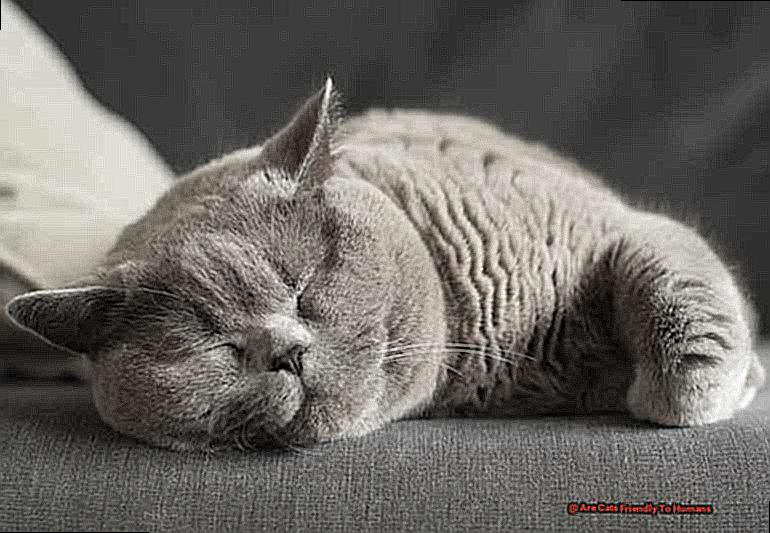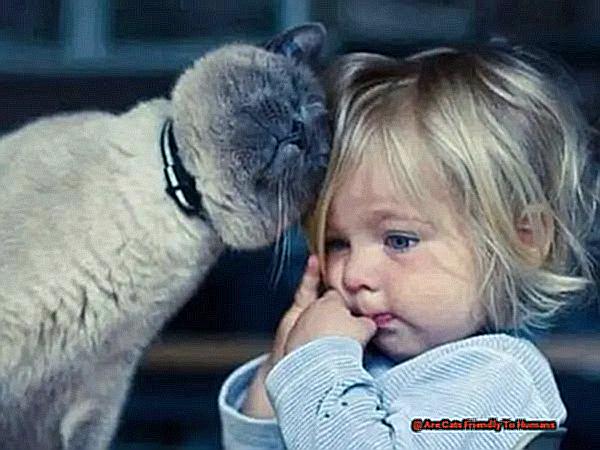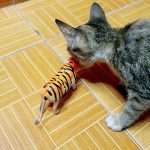Welcome to our blog where we dive deep into the mysterious world of feline behavior. Today, we’re tackling a topic that’s been debated for ages – are cats really friendly towards humans?
As proud cat owners, we know firsthand how loving and affectionate these creatures can be. But let’s face it, they also have a reputation for being aloof and independent.
Get ready to learn some unexpected facts about how cats show their love and affection towards us.
Are Cats Friendly To Humans?
Contents
When it comes to pets, cats often have a bad reputation for being aloof and unfriendly creatures. This misconception has been perpetuated by media and society, leading many people to believe that cats are not capable of forming strong bonds with humans. But as an expert on the topic of cats and their interactions with humans, I can assure you that this is far from the truth.
Firstly, it’s important to understand that cats have been domesticated for thousands of years and have a long history of living with humans. They may not show their affection in the same way as dogs do, but they are certainly capable of forming strong bonds with their human owners.
The level of friendliness displayed by a cat can vary depending on factors such as breed, upbringing, and individual personality. Some breeds, like Siamese and Ragdolls, are known for being more sociable and affectionate towards humans. On the other hand, feral cats or those that have had negative experiences with humans may be more wary and less friendly.
But even within the same breed, each cat has its own unique personality and behavior. Just like how every person is different, every cat is an individual with its own likes, dislikes, and quirks. So it’s important not to generalize all cats as being unfriendly.
Another factor that can influence a cat’s level of friendliness towards humans is their upbringing. Cats that are raised in loving and nurturing environments from a young age are more likely to be friendly towards humans and seek out their attention and affection. On the other hand, cats that have been mistreated or neglected may have trust issues and may take longer to warm up to humans.
It’s also worth noting that cats have different socialization needs compared to dogs. They are not pack animals and do not rely on human companionship as much as dogs do. This does not mean they are unfriendly, but rather they require a different level of interaction. Cats value their personal space and may become aggressive if they feel their boundaries are being invaded.
Furthermore, cats are highly sensitive creatures and can pick up on our emotions. If we treat them with kindness and respect, they are more likely to reciprocate those feelings. On the other hand, if we show fear or aggression towards them, they may respond in a similar manner.
The History of Cats and Their Relationship with Humans
Cats have been a part of human society for over 10,000 years, making them one of the oldest domesticated animals. This long-standing relationship has evolved over time, from worship and reverence in ancient Egypt to persecution during the Middle Ages and finally to the cherished companionship we know today. As a cat behavior expert, I have delved into the fascinating history of cats and their strong bond with humans. In this blog post, I will share my insights and knowledge on how cats have been intertwined with human history, particularly in ancient Egypt.
Ancient Egypt: Where Cats were Gods
In ancient Egypt, cats were revered as gods and were seen as symbols of grace and agility. They were depicted in artwork as companions and protectors of humans. This close relationship between cats and humans can also be seen in their burials, where cats were mummified alongside their human owners. The ancient Egyptians believed that cats had magical powers and could protect their homes from evil spirits.
The Divine Feline: A Table for Cat Owners
To enhance the reader’s experience, here is a table highlighting some interesting facts about cats in ancient Egypt:
| Cats were worshipped as gods |
| Depicted as companions and protectors |
| Mummified alongside their human owners |
| Believed to have magical powers |
The Cultural Shift: From Reverence to Persecution
With the rise of Christianity in Europe during the Middle Ages, cats’ status shifted from divine beings to being associated with witchcraft and dark magic. The Church saw them as companions of witches and even issued a papal decree to exterminate all cats. This led to a significant decline in the cat population and a surge in rodent infestations.
The Renaissance: A Return to Admiration
During the Renaissance period, cats once again regained their status as beloved companions. They were celebrated for their beauty and grace, and their popularity grew among the upper classes. This shift in perception paved the way for the development of different cat breeds, as people began to selectively breed them for specific traits.
Expressing Affection: How Cats Show Love and Friendship
Cats have long been known for their independent nature and aloof demeanor, leading some to believe that they are not capable of showing affection towards their human owners. However, as a cat behavior expert, I can attest that this couldn’t be further from the truth. While cats may not express love and friendship in the same way as dogs or other pets, they have their own unique ways of showing their affection towards their human companions.
One of the most common ways cats show affection is through head butting or rubbing against their owners. This behavior, known as bunting, may seem strange to us humans, but it is actually a way for cats to mark their territory and show that they feel comfortable and safe around their humans. So the next time your kitty nuzzles up against you, know that it’s not just a random action – it’s a sign of affection.
Another way cats express love and friendship is through grooming. If you’ve ever seen cats grooming each other, you know that it’s a common bonding behavior among felines. When your cat grooms you, it means they see you as part of their family and want to take care of you in the same way they would their fellow feline friends.
Some cats also show love and friendship by bringing gifts to their owners. Now, these gifts may not always be the most pleasant (think dead prey or chewed-up toys), but this behavior stems from their natural instinct to hunt and provide for their family. So while it may not be a traditional expression of love, it’s their way of showing that they care for you.
Purring is another way cats express affection towards humans. While purring can also indicate fear or stress, a cat’s purr can also be a sign of contentment and happiness, especially when they are in close physical contact with their owner. So the next time you hear your furry friend purring, know that they are showing their love for you.
Cats also show love and friendship through kneading, a behavior where they use their paws to push in and out on a soft surface. This behavior is often associated with nursing and can be seen as a sign of comfort and trust towards their human. So if your cat is kneading you while snuggled up on your lap, consider it a sweet gesture of affection.
Socialization Needs of Cats vs. Dogs: What Makes Them Different
You may have noticed that your feline friend has a different approach to socialization compared to dogs. While dogs are known for their outgoing and sociable nature, cats are often seen as more independent and aloof. But have you ever wondered why? In this post, we’ll explore the evolutionary history and domestication process of cats and dogs to understand the unique socialization needs of our feline friends.
Evolutionary History: Solitary Hunters vs. Pack Animals
Cats and dogs have been domesticated for different lengths of time, and this has influenced their socialization needs. Dogs have been domesticated for thousands of years, while cats were only domesticated in the last few thousand years. This means that dogs have evolved to become highly social animals that rely on humans for survival. On the other hand, cats are still closely connected to their wild instincts as solitary hunters.
In the wild, cats do not need to form social hierarchies or rely on their peers for survival. They are self-sufficient hunters who can survive on their own. This explains why cats may seem more independent and less interested in forming strong social bonds with humans compared to dogs.
Domestication Process: Pack Leaders vs. Providers
The domestication process has also played a significant role in shaping the socialization needs of cats and dogs. Dogs have been selectively bred for traits that make them more dependent on humans, such as loyalty and obedience. As a result, dogs see humans as pack leaders, while cats view them more as providers of food and shelter.

This does not mean that cats are incapable of forming strong bonds with their owners. It simply means that they have a different way of expressing their affection and attachment towards humans.
Communication: Vocal vs. Non-Verbal
Another factor that contributes to the differences in socialization needs between cats and dogs is their mode of communication. Dogs use a combination of body language and vocalizations to communicate with humans, making it easier for us to understand their needs and wants.
On the other hand, cats primarily use body language to communicate, which can be more challenging for humans to interpret accurately.
Factors Affecting a Cat’s Personality and Behavior Towards Humans
Are you a proud cat owner who is constantly intrigued by your feline friend’s unique personality? Do you often wonder what factors contribute to their behaviors towards humans? As an expert on the topic of cat behavior, I am here to share my insights and knowledge on the various factors that shape a cat’s personality and behavior towards humans.
Genetics and breed:
Just like humans, cats have their own distinct personalities and behaviors that are influenced by their genetics and breed. Some breeds, such as the Ragdoll or the Siamese, are known for being more friendly and affectionate towards humans. On the other hand, some breeds, like the Bengal or the Russian Blue, are known for being more independent and aloof. So if you were expecting your Russian Blue to be a lap cat, don’t be surprised if they prefer to keep their distance.
Socialization:
The way a cat is socialized during its early life also plays a significant role in its behavior towards humans. Cats that have been exposed to different people and environments at a young age are more likely to be friendly and comfortable around humans.
On the other hand, cats that have had limited socialization may be more reserved and cautious around humans. This is why it is important for kittens to be properly socialized with positive human interactions in order to develop into well-adjusted adult cats.
Previous experiences:
A cat’s past experiences with humans can greatly impact its behavior towards them. If a cat has had positive experiences with kind and loving humans, it is more likely to be friendly and affectionate towards them. However, if a cat has had negative experiences with humans, such as abuse or neglect, it may be more fearful and defensive around them. This is why it is crucial for pet owners to provide a safe and loving environment for their cats.
Owner’s behavior:
The way a cat’s owner interacts with them can also affect their behavior towards humans. If an owner is loving, patient, and respectful towards their cat, the cat is more likely to reciprocate those feelings towards other humans. On the other hand, if an owner is harsh or neglectful, it may cause the cat to develop negative behaviors towards humans. So make sure to treat your furry friend with love and kindness to foster a positive relationship.
Building a Strong Bond with Your Feline Friend: Tips and Tricks
Contrary to popular belief, cats are not aloof and unfriendly creatures. This misconception is often based on stereotypes and a lack of understanding of cat behavior. While it’s true that cats have a different approach to friendship compared to dogs, they are fully capable of forming strong bonds with their human companions.
Investing time and effort into building a bond with your cat can greatly improve the overall quality of your relationship. Just like any other animal, cats need love, attention, and affection to feel safe and secure. And when they feel safe and loved, they will show their appreciation in their own unique way.
So, how can you build a strong bond with your cat? Here are some practical tips that will help you strengthen your relationship with your feline friend:
Firstly, spend quality time with your cat every day. This could be playing together, grooming, or simply cuddling on the couch. Regular interaction will help your cat feel loved and secure in your presence.
Secondly, pay attention to your cat’s body language. Cats communicate through their body language, so it’s important to pay attention to their cues. This will help you understand their moods and needs, making it easier to bond with them.
Thirdly, use positive reinforcement techniques. Cats respond well to praise and rewards when they exhibit good behavior. So make sure to give them treats when they use their scratching post instead of your furniture or play with them when they use their litter box.
The benefits of a strong bond with your cat are numerous. Not only will it provide you with a loving and harmonious relationship, but it can also reduce stress levels for both you and your cat. Improved communication and increased trust are other positive outcomes of a strong bond.
Of course, building a strong bond with your cat may come with its own set of challenges. Some cats may have fear or aggression towards humans, making it harder to connect with them. In these cases, it’s important to be patient and understanding, and seek professional help if needed.
Remember, every cat is unique and may require different approaches to connect with them. So be patient and understanding of their personality and needs, and the bond between you and your feline friend will grow stronger over time.
Reading Your Cat’s Body Language: Communication Beyond Words
Understanding your cat’s body language is crucial for building a strong and loving relationship with your feline companion. As cat owners, we often think that our furry friends are mysterious creatures who are difficult to understand. But the truth is, cats have a complex system of communication that goes beyond just meowing and purring. By paying attention to their body language, we can decipher their feelings and needs, and in turn, enhance our bond with them.
So why is it important to understand your cat’s body language? Well, for starters, it can help you determine whether they are friendly towards you or not. A cat that approaches you with their tail held high and slightly curved at the top is showing affection and trust. On the other hand, a cat with flattened ears, dilated pupils, and a twitching tail is displaying signs of fear or aggression. This is important to note as cats can become unfriendly when they feel threatened or anxious.
Observing your cat’s posture can also give clues about their feelings towards humans. A relaxed cat will have a loose, fluid body while an unfriendly cat will appear tense and stiff. Paying attention to your cat’s eyes is also important. Wide open eyes indicate alertness and interest, while squinted eyes signal contentment and relaxation. However, if your cat’s pupils are dilated, it could be a sign of fear or aggression.
But it’s not just their body language that can tell us how they’re feeling; cats can also communicate through facial expressions. A happy cat will have a relaxed face with their mouth slightly open, while an unfriendly cat may show signs of tension in their facial muscles. And let’s not forget about grooming behavior – when a cat grooms themselves in front of you or another human, it can be seen as a sign of trust and acceptance.
However, if your cat is constantly licking their lips or grooming excessively, it could be a sign of stress or discomfort. This could indicate that they are not feeling friendly towards humans at that moment.
As a general rule, if your cat approaches you with their tail high, ears forward, and makes eye contact, it is a good indication that they are being friendly towards you.
Conclusion
In conclusion, the age-old question of whether cats are truly friendly towards humans has been put to rest. As devoted cat owners, we have experienced firsthand the love and affection these creatures can show. While they may not express it in the same way as dogs, cats are capable of forming strong bonds with their human companions.
The level of friendliness exhibited by a cat can vary greatly depending on factors such as breed, upbringing, and individual personality. It’s important to remember that every cat is unique and should not be judged based on stereotypes.
Cats have a long history of coexisting with humans, dating back to ancient Egypt where they were revered as divine beings. This close relationship has evolved over time and today, cats are beloved members of many households.
Despite their reputation for being aloof and independent, cats have their own ways of showing love and affection towards humans. From head butting to grooming to bringing gifts, these feline behaviors reveal the depth of their bond with their owners.
It’s also crucial to understand that cats have different socialization needs compared to dogs due to their evolutionary history and domestication process. They value their personal space and require a different level of interaction from humans.
Genetics, socialization, previous experiences, and owner behavior all play a role in shaping a cat’s personality and behavior towards humans. Building a strong bond with your furry friend takes time and effort but comes with numerous benefits such as reduced stress levels for both you and your feline companion.
Lastly, understanding your cat’s body language is key in effective communication beyond words. By paying attention to their posture, eyes, facial expressions, and grooming behavior, we can better comprehend our feline friends’ emotions and needs.






